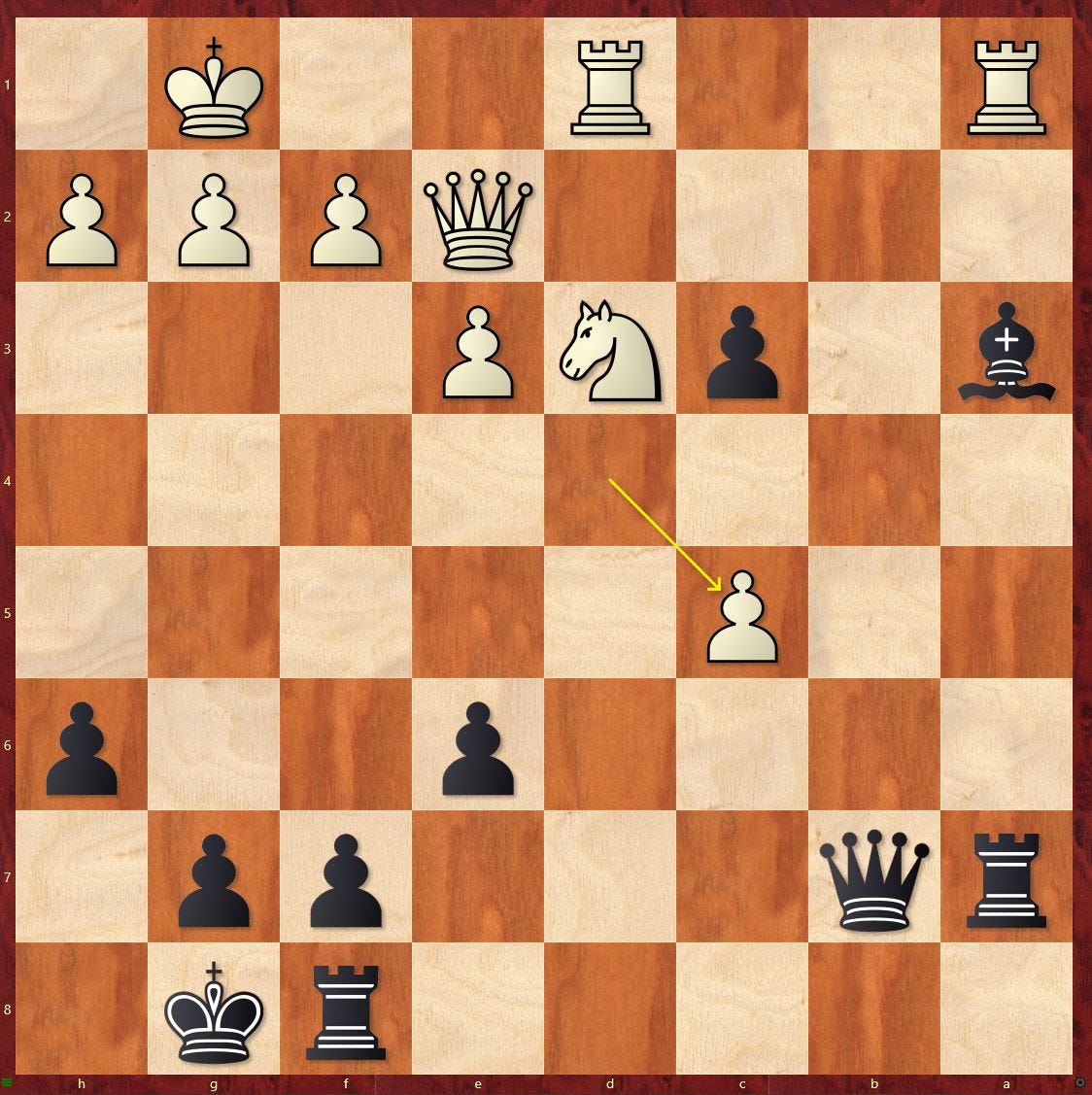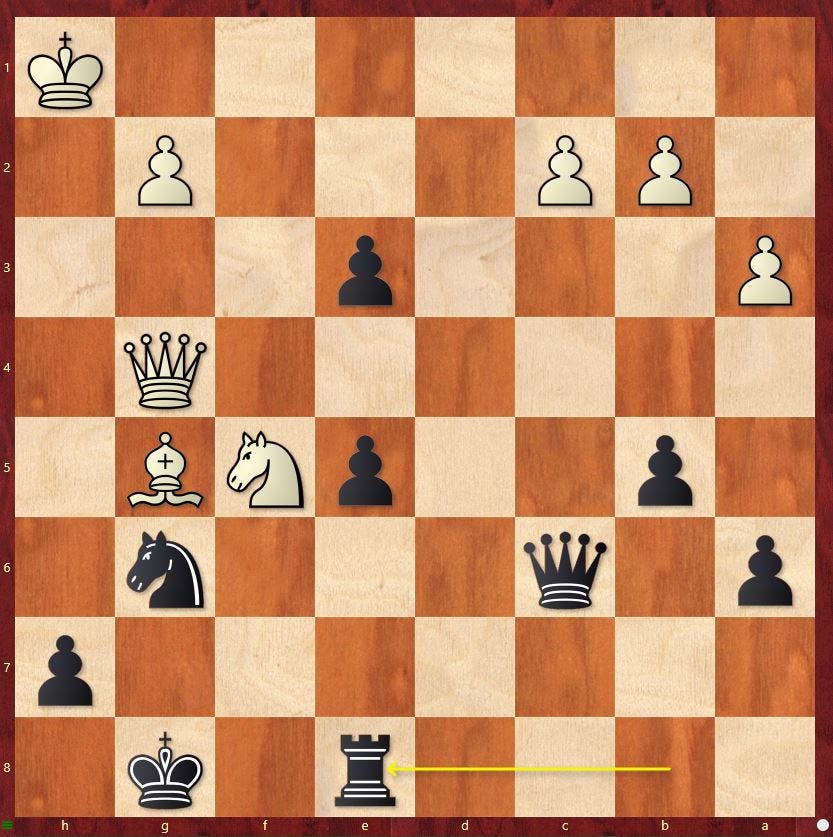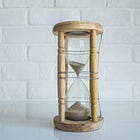Why, exactly, do you blunder in time trouble?
In this panicked state, you often lose touch with three things:
purpose,
common sense and
choices.
1. Purpose
During a game, you usually try and play moves which have a point.
When you’re in time trouble, though, you might play a random move that doesn’t do much because you just need to make a move, any move, before your flag falls.
Litchfield (2134)–Ikeda (2417), Doeberl Cup (3.5), 07.04.2023
I was down to my 30-second increment here. Black was better after 28…Qb3 or 28…Rb8 (29.Qc2 Qb3), but my mind was in chaos and I played 28…Rd8 (D).
What does this move do? I’m honestly not sure.
After the logical 29.Qc2, I couldn’t find a good move (29…Bb2 would now lose to 30.Rxa7 Qxa7 31.Nxb2 and my rook on d8 is in an unfortunate spot, like a colleague with good intentions but who makes everyone feel ill at ease), lost my c-pawn and soon after the game.
Even if I couldn’t come up with 28…Qb3 or 28…Rb8, there was a healthier move—28…Rc8 (D). This move has a clear idea of capturing on c5, which provides a safety net for Black (watch out for 29.Qc2 Bxc5 though, which loses to 30.Nxc5. Black can play 29…Bb2 instead).
Even in time trouble, or perhaps because you’re in time trouble, remind yourself to try and play a move which has a clear point.
Even if it’s not best, chances are it is better than a similar move which has no clear point.
2. Common sense
During a game, you usually have an awareness for ‘obvious’ opportunities.
When you’re in time trouble, though, you might convince yourself not to follow your common sense because you have just enough time to see a small inconvenience, but not enough time to see that you should still play the natural move.
Stojic (2226)–Ikeda (2417), Doeberl Cup (5.5), 08.04.2023
A clear exchange up, I knew I should play 36…Qh4+ here.
However, with the seconds ticking down, I saw the variation 37.Qxh4 Nxh4 38.Bg5 Ng6 39.exd4 exd4 40.Nf5 (D).
I panicked, decided against the queen exchange and played 36…dxe3 instead. The problem was that with the queens on, things are a lot trickier and after 37.Bg5 Qc6 38.Nf5, I lost on time while making the move 38…Re8 (D).
As long as I’d swapped queens with 36…Qh4+, the endgame was clearly winning even if I lose the d-pawn. But I couldn’t see that far!
Sometimes, the natural-looking moves indeed aren’t viable. But remind yourself that since you don’t have time to calculate everything, it’s often wise to just follow your instincts on general principles such as swapping queens when up material—simplifying decreases your chances to blunder or even flag.
3. Choices
During a game, you can usually choose from different options.
When you’re in time trouble, though, you can get fixated on one move and lose the ability to consider anything else.
Ikeda (2417)–Cannon (2114), Doeberl Cup (9.7), 10.04.2023
In the last few moves, I’d finally managed to win Black’s isolated e-pawn, and if Black recaptures the exchange on e5, White is in the driver’s seat.
However, I hadn’t seen 30…Qd2 (D) from afar, and totally panicked.
With the seconds ticking down, I could suddenly only see 31.Nf7+, when I win after 31…Rxf7 32.Re8+. But after 32…Kg8 (D) things had become messy. I had no idea what I’d do after 32…Kg8, so 31.Nf7+ really didn’t make sense.
Funnily enough, the best move here is to just return the knight to d6 when White is still doing alright. Instead, I played another random forcing move, 32.Bxd5 because I couldn’t think of anything else, and after 32…cxd5 (D) I was already practically lost.
Going back to the first position, 31.R5e2 (D) looks good. I must have just seen 31…Qxe2 and dismissed it without realising the winning in-between move, 32.Qxg7+. Black can retreat the queen instead, when they can still try and complicate things an exchange and a pawn down, but I’ve defended f2 and gotten out of the bishop pin.
In time trouble, we often play crazy moves because we simply lose the ability to think straight. Be mindful in advance of the fact that your brain might fixate on a particular move, and take a second (or half) to consider, “does the move I’m thinking of look sensible? Is there another move that makes more sense?”
Summing up
Remind yourself as the seconds tick down:
play a move which has a point
play a move that’s sensible
consider if the move you’re set on is the only option.
There will be times when the only way to survive a position is to find an unintuitive, unnatural move—but more often than not, keeping it simple avoids blundering.
To conclude, here’s one of the worst moves I’ve ever played—if I’d had the three pointers above in mind, let’s say I might have done better…
Ikeda (2315)–Sundararajan (2467), World Open (1.4), 28.06.2011
Which piece do I recapture on a6 with? Of course, the bishop, to keep e4 protected. Black can keep pushing, but I have good chances to hold.
I played 38.Rxa6.
My opponent couldn’t believe his eyes, and froze for 10 seconds before capturing on e4. I resigned a few moves later…
Keep it simple in time trouble.

















